Every action we do has a certain amount of risk. There are different types of risks that exist in the supply chain, which can result in either potential benefits or negative consequences. Some may have substantial advantages for the organization, such as the introduction of a new product, expansion into new markets, or outsourcing manufacturing operations, while others may have severe adverse- effects, such as health and safety risks, data breaches, criminal activities, supplier problems, additionally natural disasters could disrupt an entire supply chain.
According to a pwc survey report, several respondents consider the following to be the most significant risks to their supply chain:
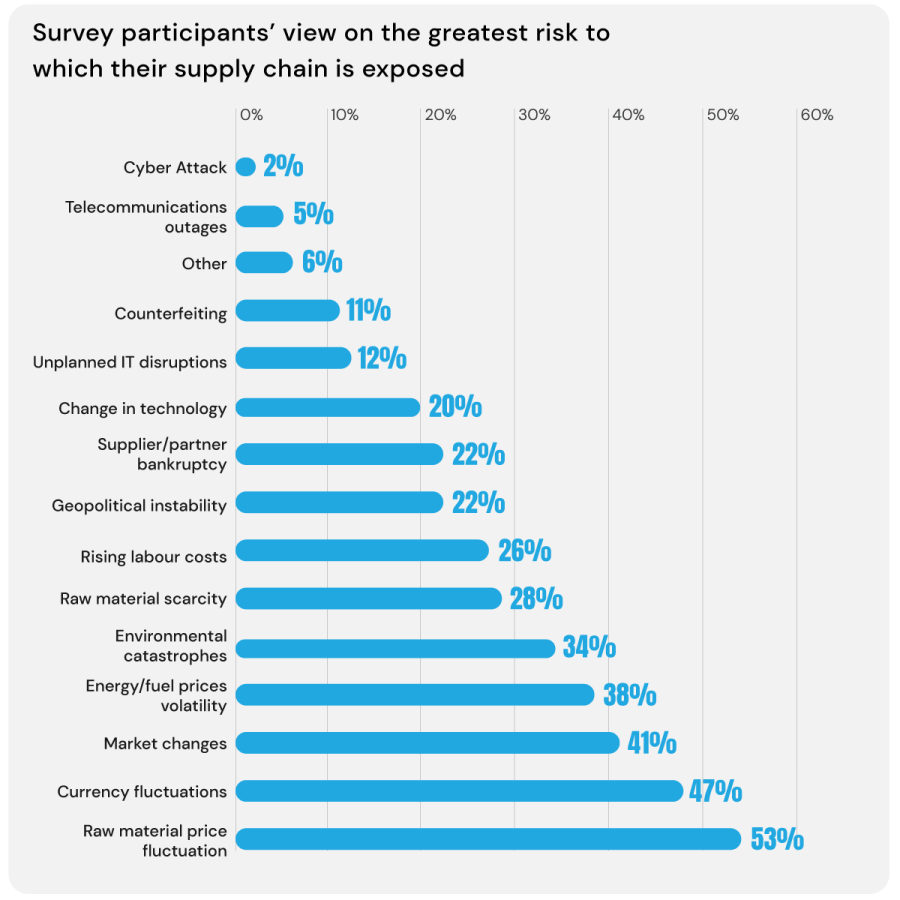
Businesses that plan for these risks or utilize diverse mitigation techniques are more likely to succeed than those that don’t. But having a mitigation plan alone is not sufficient. A strategic ability for handling the unexpected is also necessary.
In this blog, we will discuss:
- What is supply chain risk management?
- Why is it critical to manage supply chain risks?
- Types of supply chain risks.
- What are the key techniques of supply chain risk management?
Table of Contents
ToggleWhat is supply chain risk management?
In simple terms, supply chain risk management is a process used by businesses to strategically identify, evaluate, and reduce risks throughout the supply chain. It involves mitigating both extreme and everyday risks to reduce associated costs, minimize disruption, and increase the company’s profitability.
Why is it critical to manage supply chain risks?
Supply chain is critical for any organization since it comprises several operations ranging from sourcing, manufacturing, distribution of finished products, and delivery to the end customer. Hence, a failure to deliver at the expected time in a single process can lead to disruption of the entire supply chain. Moreover, with 43% of third-party relationships not subjected to any kind of due diligence checks, and just 21% of firms claiming to have a highly robust supply chain network with strong visibility and flexibility, clearly businesses need stronger supply chain risk management techniques to prevent negative outcomes like lack of raw materials, decreased revenues, loss in market share, cost fluctuations with the risk of inflated prices, and overall damage to the organizational reputation with poor customer satisfaction.
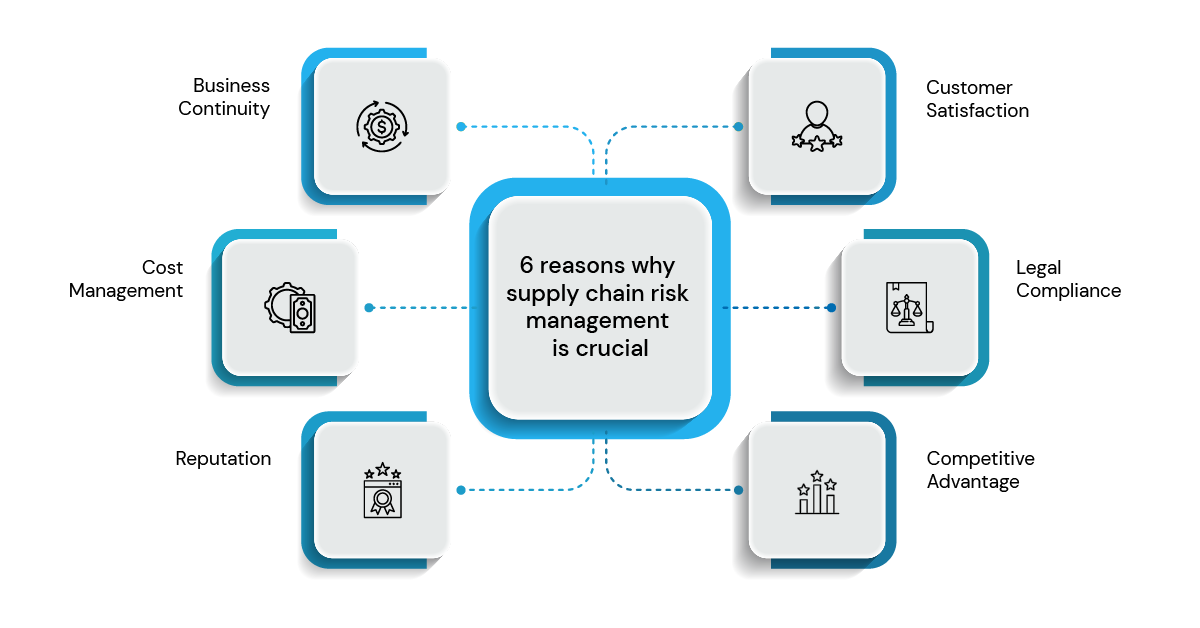
Here are some reasons why supply chain risk management is crucial:
1. Disruptions in the supply chain can lead to delays in production and delivery, which can result in lost sales and revenue. By managing supply chain risks, organizations can minimize disruptions and maintain business continuity.
2. Cost management: Supply chain disruptions can result in increased costs, such as expedited shipping, additional inventory holding costs, and lost productivity. Effective supply chain risk management can help reduce these costs by identifying potential risks and developing mitigation strategies.
3. Reputation: Supply chain disruptions can also have a negative impact on an organization’s reputation. For example, if a product is recalled due to quality issues, it can damage the company’s brand and lead to a loss of customer trust. Effective supply chain risk management can help prevent these types of incidents.
4. Customer Satisfaction: Customers have come to expect faster delivery times, lower costs, and greater product variety. Supply chain disruptions, such as natural disasters, political instability, or supply shortages, can lead to delays in product delivery, increased costs, and lost revenue. By proactively managing supply chain risks, companies can enhance customer satisfaction and loyalty, which can lead to increased sales and profitability.
5. Legal compliance: Non-compliance with laws and regulations related to the supply chain can result in legal penalties, fines, and lawsuits. Effective supply chain risk management can help ensure compliance with regulations and minimize legal risks.
6. Competitive advantage: Organizations that effectively manage supply chain risks can gain a competitive advantage by being able to respond quickly to unexpected events and disruptions. This can lead to increased customer loyalty and market share.
A thorough SCRM (Supply chain risk management) strategy can help organizations to become resilient and adaptable to reduce the risks associated with the supply chain. This requires managing every type of risk at every stage of the supply chain. When implemented successfully, SCRM can provide a considerable competitive edge over other companies.
Types of supply chain risks
The supply chain is quite complex, which exposes it to several risks. These risks can be significant and can impact an organization’s operations, finances, reputation, and overall competitiveness. The primary kinds of risks that businesses may experience are:
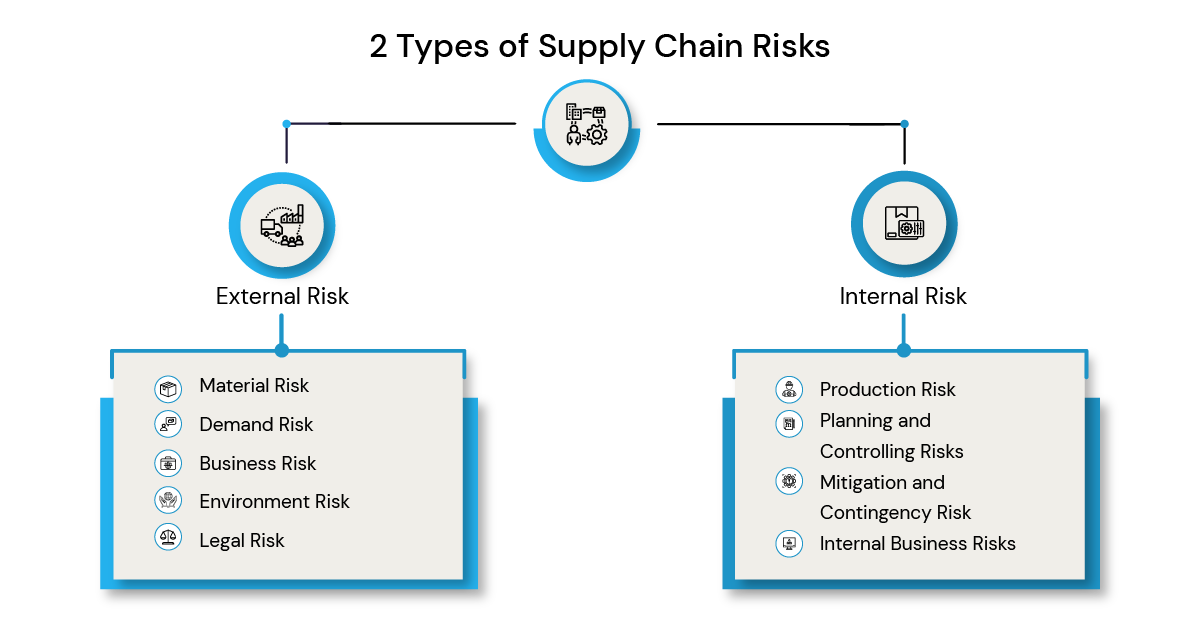
1. External risks
The external supply chain risks, as the name indicates, originate outside of your organization. Unfortunately, this means they are more difficult to predict and usually necessitate more efforts to mitigate.
i. Material risks
Material risks arise when raw materials, components, or completed items are late or don’t arrive. These risks might cause operations to be delayed or even halted, particularly for manufacturers and distributors of physical commodities.
ii. Demand risks
They are generated when inaccurate demand estimations result in excess inventory or an inability to satisfy current demand. These risks have the potential to ruin brands, seriously harm sales and earnings, and affect supplier relationships.
iii. Business risks
Occurs whenever one of the organizations you depend on for the seamless operation of your supply chain experiences unanticipated changes.
iv. Environmental risks
These risks stem directly from social-economic, political, governmental, or environmental problems that influence the timeliness of any supply chain component. In a Deloitte poll, 47% of respondents said that in the coming years, managing ESG (Environmental, Social and Governance) risks will be a high priority for their organizations.
v. Legal risks
Legal risks are those connected to the business’s operating environment’s legal framework. These may include elements like trade restrictions and labor law. Businesses must take action to abide by local rules and regulations to reduce the risks of evolving legal and regulatory frameworks.
2. Internal risks
The risks under a company’s control and maybe foreseen and controlled are referred to as internal risks of the supply chain. Businesses may keep an eye on potential internal risks using software and data & analytics that generate patterns and observations.
i. Production risks
It’s the risk that arises when a critical component or phase in your production/manufacturing process may be disturbed, leading operations to run late. For example, a significant workflow delay or a major piece of equipment failure can easily derail your production, sales, and delivery timelines.
ii. Planning and control risks
Inaccurate predictions and evaluations, poorly planned production, and incompetent management all contribute to planning and control risks. If a company does not maintain an accurate inventory, it can lead to stockouts or excess inventory, resulting in financial losses.
iii. Mitigation and contingency risks
If your company doesn’t have a backup strategy in place to tackle supply chain interruptions, then there may be risks associated with mitigation and contingency.
iv. Internal business risks
Changes within your organization that are unforeseen or inadequately handled constitute an internal business risk. Workflow inefficiencies, ineffective communication, lack of training, lagging company culture, a poorly handled merger, or an absence of collaboration across business divisions can all increase the risk.
What are the Key strategies of Supply Chain Risk Management (SCRM)?
Businesses with weak supply risk management practices are often vulnerable to failure. Thus, organizations must implement effective risk management strategies that enable them to be prepared for any eventuality. To manage risks effectively, the following strategies are recommended:
1. Identify & prioritize risks
The first strategy in SCRM is the identification of risks. This includes both internal and external risks; assessing all nodes, including manufacturing, suppliers, transit, and warehouses for risks that may have an impact on the pricing, quality, and distribution of your items, as well as on your brand success.
Assess the impact of these risks on the organization’s supply chain and prioritize risks based on their likelihood and severity and devise a preventative supply chain risk mitigation approach, beginning with the one which is most likely to take place and has the largest possible impact on your firm.
2. Make use of the PPRR Risk Management Model
Businesses all around the world utilize the PPRR risk management methodology, which stands for:
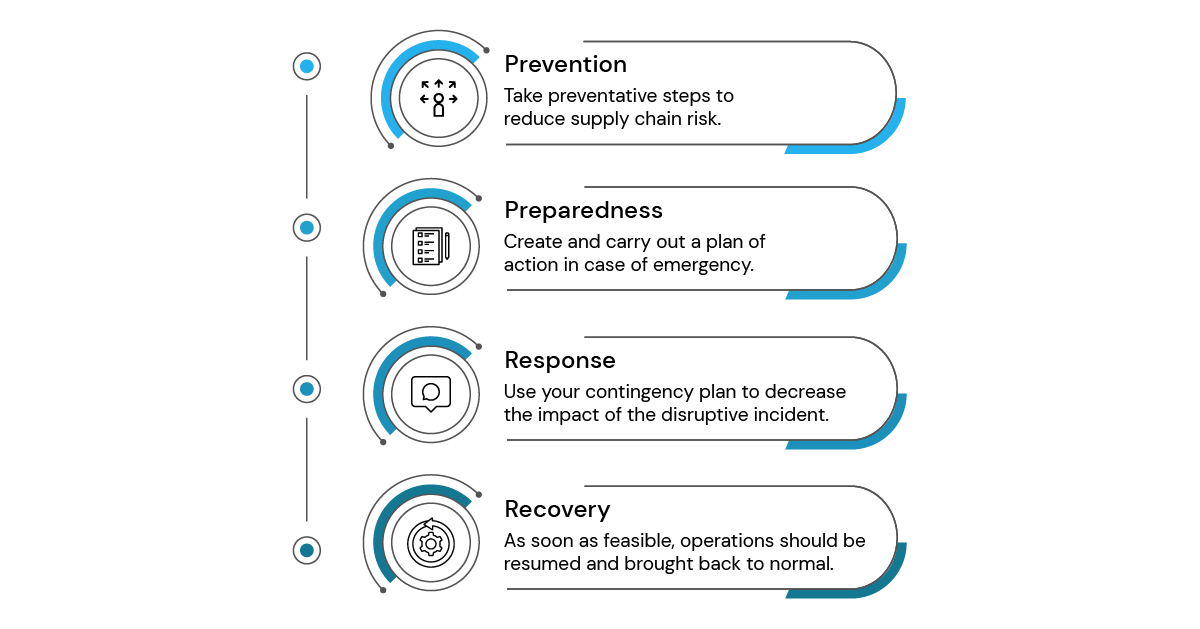
3. Employ strategic supplier risk management
One of the key elements of any efficient supply chain risk management plan is gaining visibility and control over potential supplier risks. Let’s examine it in terms of three phases of a supplier management process.
i . Supplier onboarding
This involves verifying identities, doing KYC checks, and following all fundamental sanitation processes before beginning a supplier partnership. This process is necessary to make sure potential suppliers are compliant with the regulatory framework and have the resources to meet your demands and provide them a chance of becoming acquainted with your internal processes and structures. A comprehensive onboarding strategy will minimize risks to your business and profitability, optimize procurement processes, increase efficiency, and establish the groundwork for long-lasting supplier relationships.
ii. Supplier risk assessment
Considering the many risk dimensions allocated to each supplier and their third-party contacts, such as geographic/logistical risk, reputational risk, and economic risk, the suppliers are evaluated for legislative compliance, financial stability, and other data factors including PEP (Politically exposed person) checks, AML (Anti-money laundering) checks, anti-bribery compliance, and sanctions breaches. One easy way of performing supplier assessment is by using a supply chain risk management solution that uses sourcing and procurement analytics and automates supplier performance management through supplier questionnaires, calculating risk scores, sending out corrective actions, and providing timely notifications for actions on high risk.
iii. Supplier risk monitoring
At this stage, you must continuously keep an eye on the major events that influence the risk of your suppliers. To obtain a dynamic perspective of a company’s risk profile, you must implement systems that gather critical risk indicators in real-time from a variety of data sources, such as statutory compliance and financial filings.
4. Expand supplier base
Depending on a single supplier intensifies risks and associated problems that may probably affect your entire supply chain. But with a diversified supplier base, you can not only enhance supply chain resilience but also gain the opportunity to enhance your supplier sourcing strategy by choosing to work with suppliers and contractors having specialized knowledge and locate items and services at the best prices while ensuring profitability and quality of the products.
5. Strengthen Cybersecurity
Another strategy is cyber security supply chain risk management. This technique guards against cyberattacks that might harm the company or result in the loss of data or information. Adequate steps may be taken to ensure cybersecurity, through:
- Establishing compliance requirements to protect the privacy, accessibility, and integrity of information systems.
- Appropriate administrative controls, including user identification, attributes, and passwords, for the systems.
- Creating backup protection strategies to maintain your data backups.
- Maintaining up-to-date anti-virus, anti-spyware, and firewall software program for your business, and consider using extensive cybersecurity safeguards like DNS filtering and network access management.
6. Monitor Freight Metrics
Tracking your freight metrics can assist you in ensuring that products arrive on schedule. From the time a shipment leaves the warehouse until it reaches its destination, its journey must be tracked. Bar codes, RFID tags, and GPS tracking technologies can all be utilized for this purpose. Companies can also monitor and evaluate the transport efficiency of the carriers and decide on changing transportation provider or route if potential issues are identified.
7. Create a logistics contingency plan
Businesses must have a logistics contingency strategy in place to maintain company stability in case of a supply chain disruption. Here are some ideas for developing a contingency plan to reduce logistics risk in the supply chain:
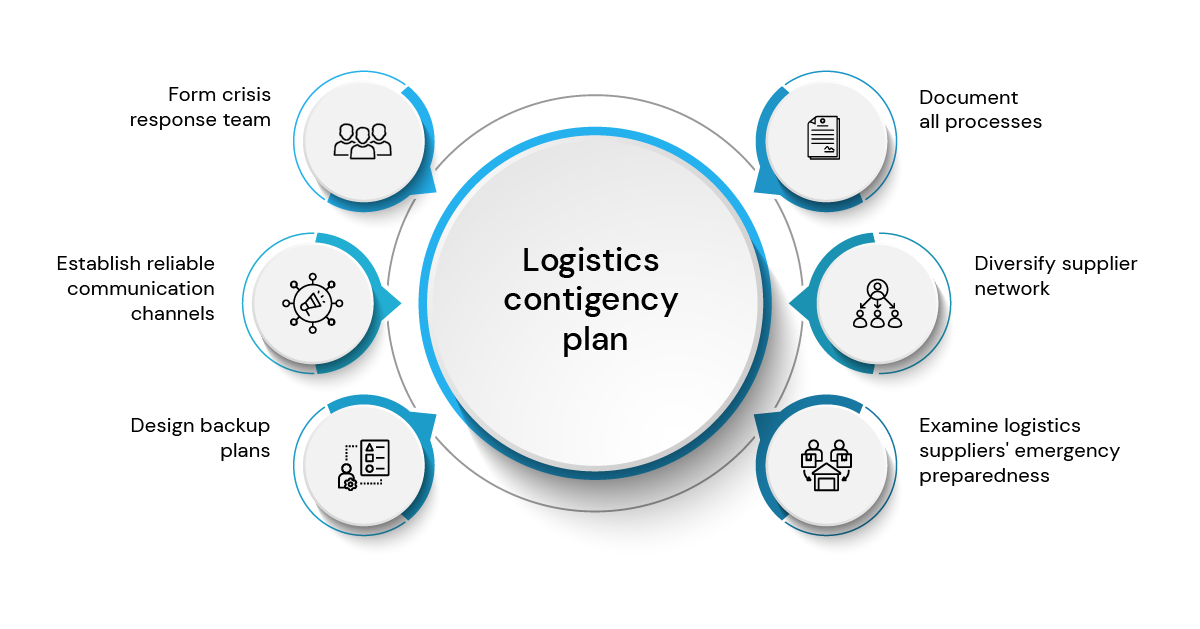
8. Promote risk awareness
When supply chain risk management is done collaboratively, it becomes simpler and easier. By fostering a risk-aware culture in your organization you can guarantee that all employees and strategic partners engaged in your production process adhere to the utmost risk management standards, therefore lowering the risk of supply chain disruptions. You can ensure that every aspect of your supply chain is compliant and responsive to your risk mitigation measures by incorporating training manuals, fostering clear communication, and establishing organizational targets and benchmarks.
9. Constantly review supply chain risks
Your SCRM (supply chain risk management) techniques will be effective only if they are updated and applicable to all supply chain activities. Thus, doing a risk assessment once will not suffice. You must examine supply chain risks frequently to guarantee that control methods and intended actions for different situations stay viable.
10. Investment in risk management software and technologies
Risk management systems powered by data science and technology have shown promising outcomes. To manage your supply chain and its associated risks more efficiently and precisely, you must invest in a centralized, cloud-based supply chain risk management software reinforced by technologies like RPA (robotic process automation) and machine-learning-based analytics.
A comprehensive strategic procurement software like MeRLIN, backed by robust technologies, strategic sourcing techniques, supplier performance management features, and supplier intelligence capabilities, enables enterprises to continuously monitor expenditure, choose preferred suppliers, reduce supply risks, and optimize the supply chain while also measuring, evaluating, and tracking supplier performance.
Conclusion:
In summary, implementing effective risk management is essential for organizations to protect their assets, enhance decision-making, comply with regulations, maintain their reputation, save costs, and gain a competitive advantage. By effectively implementing a defensive risk management strategy, businesses can identify risks, evaluate them, and ensure that their processes can persevere through disruptions without compromising on operational efficiency.
However, if you find monitoring and mitigating supply chain risks challenging, you do not have to go through it alone. Get in touch with us to learn more about how MeRLIN can assist you in adopting compliance, risk management, and a regulatory framework for your supply chain risk management operations.
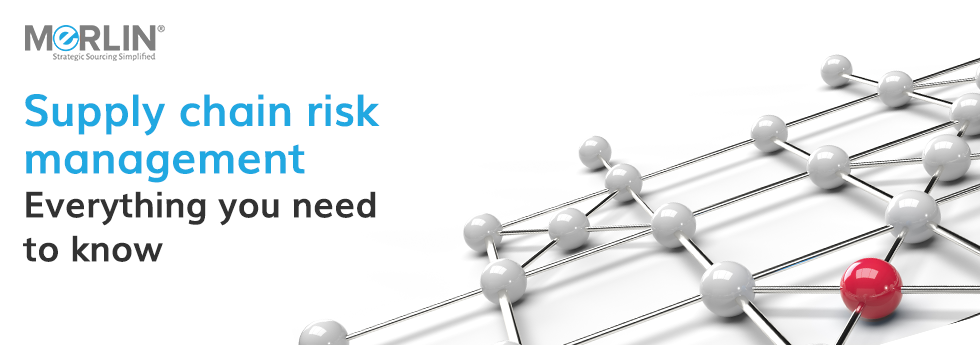



5 comments
Very informative and well-articulated post. Thank you.
Thanks for your comment. We are glad that you found this post informative!
Thank you for the comments. We are glad that you found this article informative!
Very educative information on Supply Chain Risk Management. I like much the appreciation of that proper SCM can increase revenue or cut cost to the Organization. I have vast experience in Public Procurement in my Country, one greatest set back to the Organizations is not providing enablers for managing the supply chain to the fullest.
Thanks for your comment. We are glad that you found this post informative!